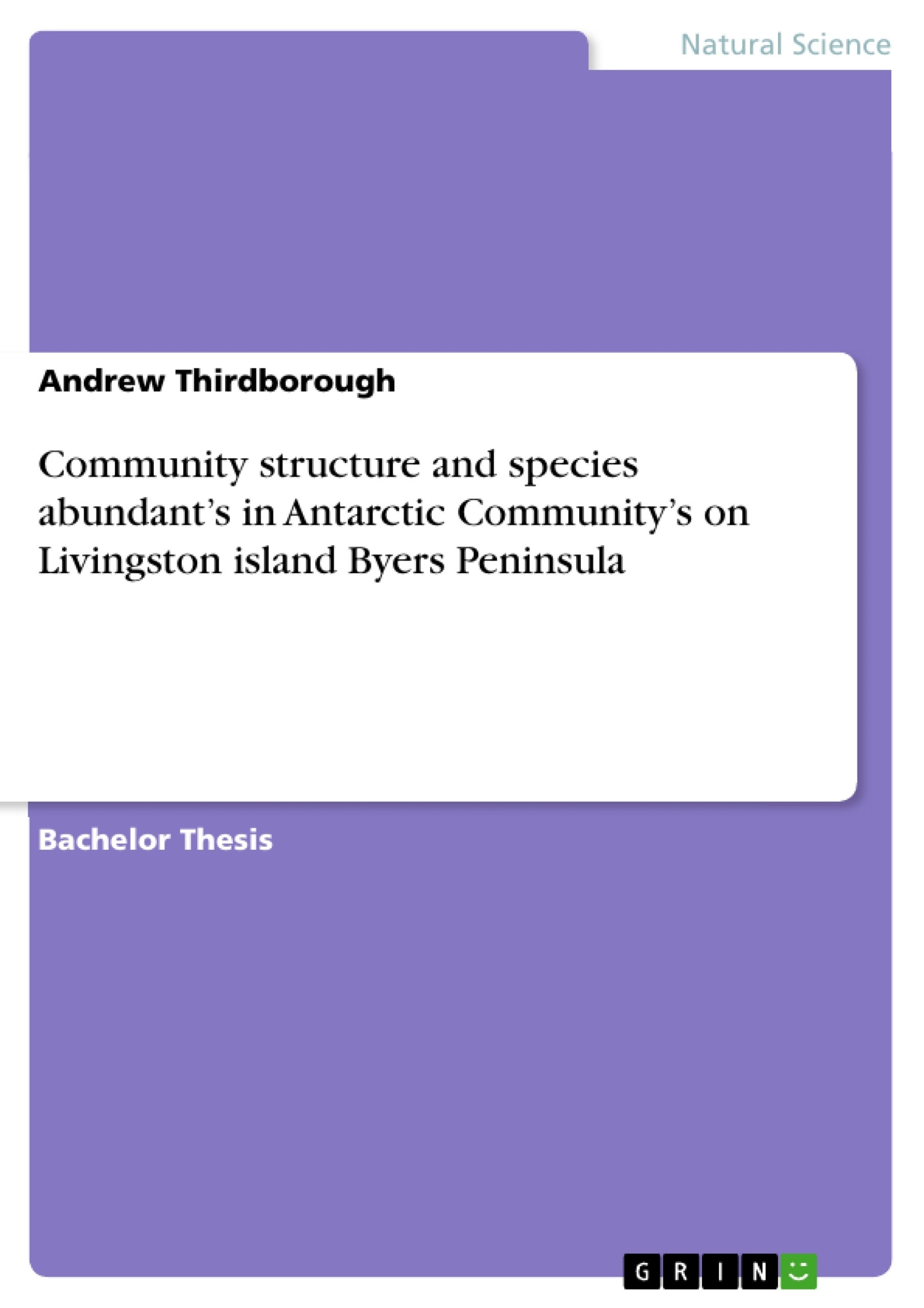This study was carried out in the lab to identify species that were collected from three sites (Cape Smellie, Past Clark and Nunatak) on Byers peninsula, Livingston Island South Shetland Islands. The study was to investigate whether the length of time a site had been ice free affected community structure. It was found that Cape Smellie had the highest species richness with sixteen more species than Past Clark and twenty-nine more species than Nunatak. Cape Smellie also had the highest of species and was the site that had been ice free for the longest time period +50 years and the Nunatak samples showed a higher diversity than the other two site samples and is the site that has been ice free for less than 10 years. All of the sites sampled were found to have high numbers of Laevilltorina calignosa, Donacidae, Spinonid, Plathyhelminthe and Amphipods, all of which are highly adaptive species to different stress gradients and are all found worldwide in different types of ecosystems. The main findings in this study suggest that glacial retreat could be a possible cause for the increase in species as the data shows that glacial retreat over time co-insides with the increase in species abundant richness and diversity found on the different sites. There is a good possibility that there are different stages of colonisation by different species being seen in this study, and that location of the sites and the different stress gradients, substrata and exposure are possible controlling factors in the type of species and their found at the different sites. All three study sites had ten of the same species present; amphipods two, three, four, six, and nine, Terrebellida, Nephtyidae, Donacidae, Plathyhelminthe one and two and Enchytraeidae, but as likely, the substrata and different stress gradients i.e. wave intensity tolerance to freezing, the dominant species found on the study sites at Byers peninsula also correspond with the majority of studies carried out on other islands in and around the Antarctic region.
Inhaltsverzeichnis
- Abstract
- Introduction
- Methods and materials
- Collection method in the field
- Site descriptions
- Method used in lab
- Statically analysis used
- Hypothesis
- Collection method in the field
- Results
- ANOVA on species richness abundant's and diversity
- MDS analysis
- ANOSIM
- SIMPER Species that define the communities
- Discussion
- Conclusion
- References
- Appendix
- Arial photographs of ice retreat on Livingston Island
- Site pictures of sample sites
- Identification recourses used
- amphipod identification list
- species list with identification pictures
- presence absence list
Zielsetzung und Themenschwerpunkte
This study aims to investigate the impact of glacial retreat on the community structure of intertidal species on Byers Peninsula, Livingston Island, South Shetland Islands. The study specifically examines whether the length of time a site has been ice-free influences the species richness, abundance, and diversity of the intertidal community.
- The influence of glacial retreat on intertidal community structure.
- The relationship between time since ice retreat and species richness, abundance, and diversity.
- The role of environmental factors, such as substrata and stress gradients, in shaping intertidal communities.
- The adaptation strategies of intertidal species to harsh Antarctic conditions.
- The comparison of species composition and diversity across different sites with varying ice-free periods.
Zusammenfassung der Kapitel
The study focuses on three sites on Byers Peninsula: Cape Smellie, Past Clark, and Nunatak, each with varying lengths of time since glacial retreat. The study utilizes a combination of field collection methods and laboratory analysis to assess species richness, abundance, and diversity. The results indicate that Cape Smellie, the site with the longest ice-free period, exhibits the highest species richness and abundance. Conversely, Nunatak, the site with the shortest ice-free period, shows higher diversity. The study suggests that glacial retreat plays a significant role in shaping intertidal communities, with different stages of colonization observed across the sites. The study also highlights the importance of environmental factors, such as substrata and stress gradients, in influencing species distribution and abundance.
Schlüsselwörter
The keywords and focus themes of the text include glacial retreat, intertidal community structure, species richness, abundance, diversity, Byers Peninsula, Livingston Island, South Shetland Islands, Antarctic, environmental stress, substrata, stress gradients, adaptation strategies, colonization, and biodiversity.
- Quote paper
- Andrew Thirdborough (Author), 2011, Community structure and species abundant’s in Antarctic Community’s on Livingston island Byers Peninsula, Munich, GRIN Verlag, https://www.grin.com/document/276442
-

-

-

-
Upload your own papers! Earn money and win an iPhone X. -

-
Upload your own papers! Earn money and win an iPhone X. -

-
Upload your own papers! Earn money and win an iPhone X. -

-
Upload your own papers! Earn money and win an iPhone X. -

-
Upload your own papers! Earn money and win an iPhone X. -

-
Upload your own papers! Earn money and win an iPhone X. -

-
Upload your own papers! Earn money and win an iPhone X. -

-
Upload your own papers! Earn money and win an iPhone X. -

-
Upload your own papers! Earn money and win an iPhone X. -

-
Upload your own papers! Earn money and win an iPhone X.

